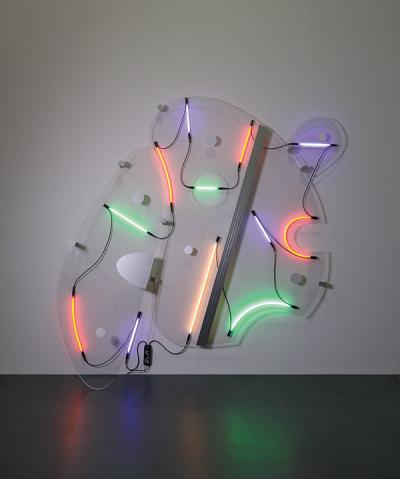Sonnier Casts a Spell at Pace

Not every artist manages to continue refreshing his work into his 70s, but Keith Sonnier, through the aid of a new studio space in Bridgehampton, has managed to do just that. The evidence is on view at Pace Gallery in Chelsea through Feb. 22.
The artist chose his most regular medium quite early in his career. Graduating from Rutgers University with an M.F.A. in 1966, it was only two years later that he began working in the neon gas lighting that has defined his sculpture ever since.
There are eight works from the past year in the front two rooms of the gallery, along with a few pieces from his earliest series in the back for context. The juxtaposition shows an artist who has gained lyricism and grace in his later years. It also shows a return to some of the earliest visual explorations of his career for a re-evaluation and reinvigoration of those themes.
The earliest sculptures were no doubt breakthroughs in their time and still look fresh, if a little stilted and even crude. That is really only a byproduct of their relation to the newer works.
The two “Neon Wrapping Neon” works from 1969 play with both the light and geometry of the bent tubing to create illusions of perception as they draw in space with the colored gas, both in three dimensions and suggestive of it. They imply depth where none exists in bold primary colors that may also include green.
“Neon Wrapping Incandescent,” also from 1969, offers early evidence of a more joyful and playful side of the artist and a willingness to explore his ability to bend the glass tubes into curvaceous as well as hard angular shapes. The prettier colors, a pale pink and blue, are reminiscent of a baby shower decoration, offered as a description not to diminish the work’s appeal as an art object, but more to highlight its happy optimism.
“Ba-O-Ba V” from 1970 is representative of the series that arguably begins the artist’s maturity. This is the work that epitomizes his breakthrough years and a way of organizing light, wire, and glass that he would return to regularly. It also has the most to say in comparison to his contemporary work.
As long as critics and art historians have written about Mr. Sonnier, they have been defining “Ba-O-Ba.” In Sabine Vogel’s 2004 catalogue essay for a show in Germany, she concisely stated that the expression, derived from the French Creole dialect in Mamou, La., where he grew up, means an effect of light on skin and the body that exercises a physical and suggestive power of attraction. It can come from both natural and artificial light.
Here, three straight lines of neon lights are offset by two large glass disks, one with a green tube bisecting it, the other with a red tube spanning a shorter distance. A smaller blue tube acts like a lifeline between the two, joining them up like train cars or a rudimentary biological form. There is no overt resemblance to actual physical objects. As Donald Kuspit noted in a 1989 essay, these are examples of absolute art, non-objective, yet still with “ghosts of language and the figure.” With their curves, undulation, and colorful light, they breathe with a theatricality and expressiveness that draws one in the way a flower’s bright colors invite bees to pollinate.
The shift to a more complex examination of similar compositions in his 2013 works belies decades of the artist’s work in more complex forms. These involved expressive sculpting of the neon tubing, additions of steel, mirrors, and found detritus such as old detergent bottles. Although discussed in the catalogue, none of it appears to matter to the aims of the current exhibition, which is a wise decision. The newer works are so much more related to these earlier defining moments than what has come between the years, even as they borrow some of the maximalism of that interim creative period.
“Mirrored Slant” and “Lunar Slice,” which are hard-edged in their primary hues and more industrial in configuration, seem to stand apart in the shared space of the front gallery rooms. Their more Euclidian purity begins to blow up quickly in the wake of “Lobbed Shape,” an amoeba-like form that breaks apart the neon into smaller discrete pieces of softer-hued blends of purple, green, and salmon.
On and on the pieces go in their dissolution, creating odd and almost anthropomorphic shapes and drawing on the expressiveness not only of the tubes but more than ever before of the electrical wire that unites them, providing a solid connective tissue and structure for the swathes of gaseous color, much the way a pounced cartoon would have done for a fresco in the Renaissance.
The installation is so pure in its dialogue between past and present, it is almost too much to see works that do not completely fit into this model. These include the earlier sculptures that provide context for “Ba-O-Ba V” as well as last year’s “Zig Zig Square” that, while engaging because of its difference, breaks the spell of the more amorphous compositions on display.
In the essay for this exhibition, Richard Shiff pointed out that the play of neon on the initially glass but now acrylic pieces that Mr. Sonnier uses alludes to the definition of that initial title. He calls them skins and describes their function as mediating the refraction and perception of the light that is placed behind or outside them, which, in turn, creates beautiful effects on that skin. The effect is mesmerizing and just as described.
